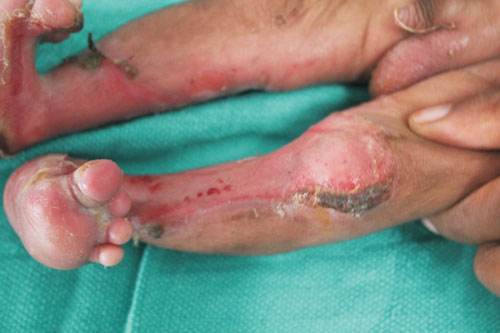|
|
|
Indian Pediatr 2019;56: 1083 |
 |
Bart
Syndrome
|
|
Shekhar Neema 1,
Sweta Mukherjee2
and Subhash Chandra Shaw3
Departments of 1Dermatology and 3Pediatrics,
Armed Forces Medical College; and 2Department of Pediatrics,
Command Hospital; Pune, Maharashtra, India;
Email:
[email protected]
|
|
A 27-day-old neonate, product of 3rd degree
consanguineous marriage, youngest of three siblings, presented with
complaints of absence of skin of medial aspect of both legs and nail
dystrophy, and fluid-filled lesions on trauma-prone sites of body since
2nd day of life. Examination revealed absence of skin involving
anteromedial aspect of shin and dorsum of both feet (Fig. 1).
Nails were dystrophic. Multiple erosions involving buttocks, elbows and
occipital scalp were noted. Mucous membranes were normal.
Histopathological examination of cutaneous blister revealed subepidermal
blister and absence of inflammatory infiltrate on histopathology and
immune complex on direct immunofluorescence. A diagnosis of Bart
syndrome with underlying Junctional or Dystrophic epidermolysis bullosa
was made. Erosions were covered with paraffin gauze dressing, thin layer
of mupirocin and non-adherent dressing. Parents were counseled about the
favourable outcome of the disease.
 |
|
Fig.1 Absence of skin over
anteromedial aspect of shin and dorsum of both feet in Bart
syndrome.
|
Bart syndrome is rare disorder characterized by triad
of congenital localized absence of skin (CLAS), mucocutaneous blistering
and nail abnormalities. CLAS is classically present as S-shaped area
from knee to anterolateral surface of leg, ankle and foot, and is
generally bilateral. Cause of CLAS has been proposed to be rubbing of
limbs together in utero. It may represent any of the three
subtypes of epidermolysis bullosa: simplex, junctional or dystrophic.
Diagnosis is confirmed by histopathological studies, antigen mapping and
genetic studies. Prognosis is favourable in absence of other anomalies
as localised absence of skin heals with minimal scarring and blistering
improves with time.
|
|
|
 |
|

